Studiologic VMK161 User Manual [en, de, es, fr, it]
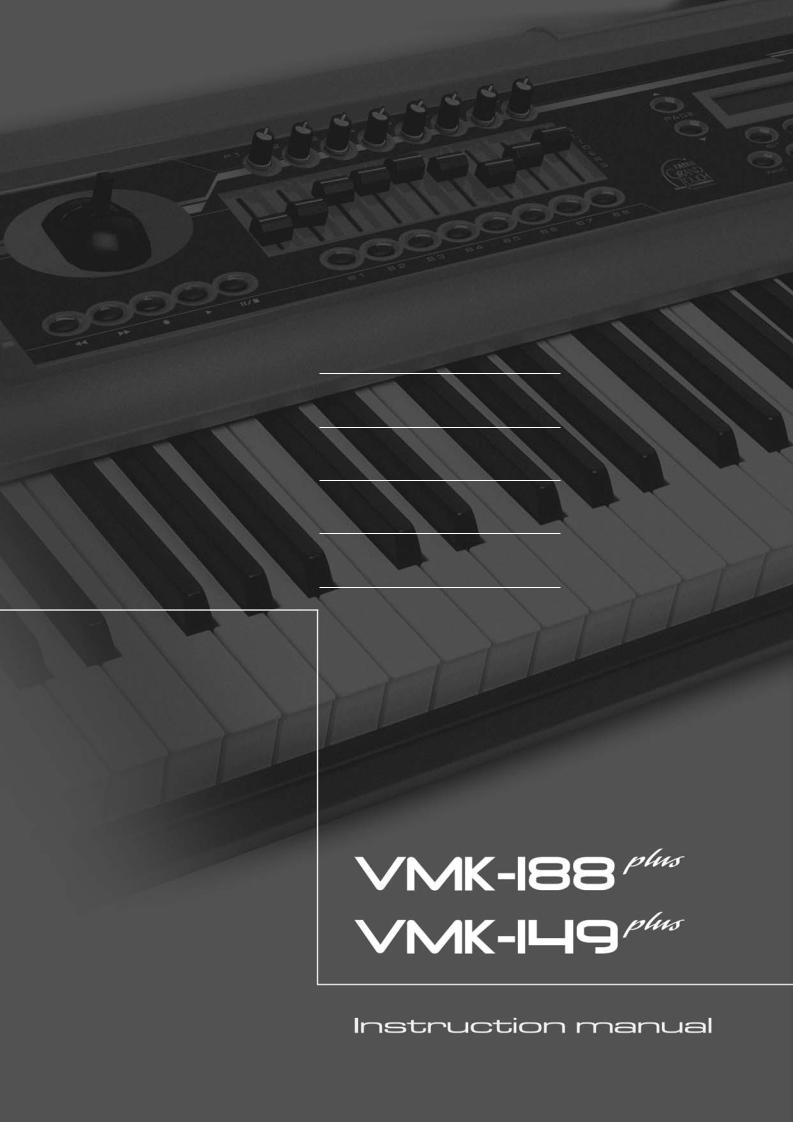
ENGLISH |
01 |
ITALIANO |
20 |
DEUTSCH |
39 |
FRANÇAIS |
58 |
ESPAÑOL |
77 |

I n s t r u c t i o n m a n u a l |
VMK-149plus/VMK-188plus |
|
|
VMK INTRODUCTION |
2 |
CONTINUOUS CONTROLLERS |
3 |
KEYBOARD LAYOUT |
4-6 |
PRESET CREATION: A SUMMARY |
7 |
PROCEDURES: |
|
PRESET SELECTION AND NAMING |
8-9 |
KEYBOARD PROGRAMMING |
10-12 |
SLIDERS/KNOBS PROGRAMMING |
13-14 |
BUTTON PROGRAMMING |
15-16 |
PEDAL PROGRAMMING |
17-18 |
LIVE EDIT |
19 |

I n s t r u c t i o n m a n u a l |
VMK-149plus/VMK-188plus |
|
|
VMK INTRODUCTION
Welcome to the wonderful world of the Studiologic VMK series!
The VMKs are multi-level programmable keyboard controllers The VMK-149plus is the world’s first keyboard with 49 full-weighted piano keys, and the VMK-188plus has an 88-note keyboard.
Both have the famous FATAR key action.
They are functionally identical except for the number of keys. Both units feature pitch bend, aftertouch, “on the fly” live edits, assignable knobs, buttons and sliders, and 2 independent fully programmable pedal inputs.
Just look at what they have available to assign:
•8 programmable knobs X 2 banks;
•8 programmable buttons X 2 banks;
•9 programmable sliders X 4 banks;
•A 5-button programmable transport section;
•And 3 programmable pedal inputs.
That’s a total of 77 assignable controls!
The VMKs are professional keyboards with built-in control surface capability. It is a control surface MIDI keyboard with 3 software presets, 27 user programmable patches, and an unbeatable combination of assignable knobs, buttons, sliders and pedals. It allows you to tweak your sessions to your heart’s content.
And it’s all with a budget-conscious studio in mind.
Key Features:
•VMK-149plus: 49 FULL SIZE KEYS with WEIGHTED ACTION
•VMK-188plus: 88 FULL SIZE KEYS with WEIGHTED ACTION
COMMON FEATURES TO BOTH UNITS:
•TOUCH SENSITIVE
•PROGRAMMABLE AFTERTOUCH
•PITCH BEND
•PROGRAM CHANGE / BANK SELECT/ MIDI CHANNEL
•9 PROGRAMMABLE SLIDERS
•8 PROGRAMMABLE KNOBS
•8 PROGRAMMABLE BUTTONS
•5 BUTTON PROGRAMMABLE TRANSPORT CONTROL
•3 PROGRAMMABLE PEDAL INPUTS
•3 SOFTWARE PRESETS:
1- NATIVE INSTRUMENTS B4;
2 - STEINBERG CUBASE;
3 - NATIVE INSTRUMENTS PRO 53
•27 USER PROGRAMMABLE PATCHES
•DUAL MIDI OUTPUTS
•CARRY BAG AND FOOTSWITCH INCLUDED
2
V M K i n t r o d u c t i o n
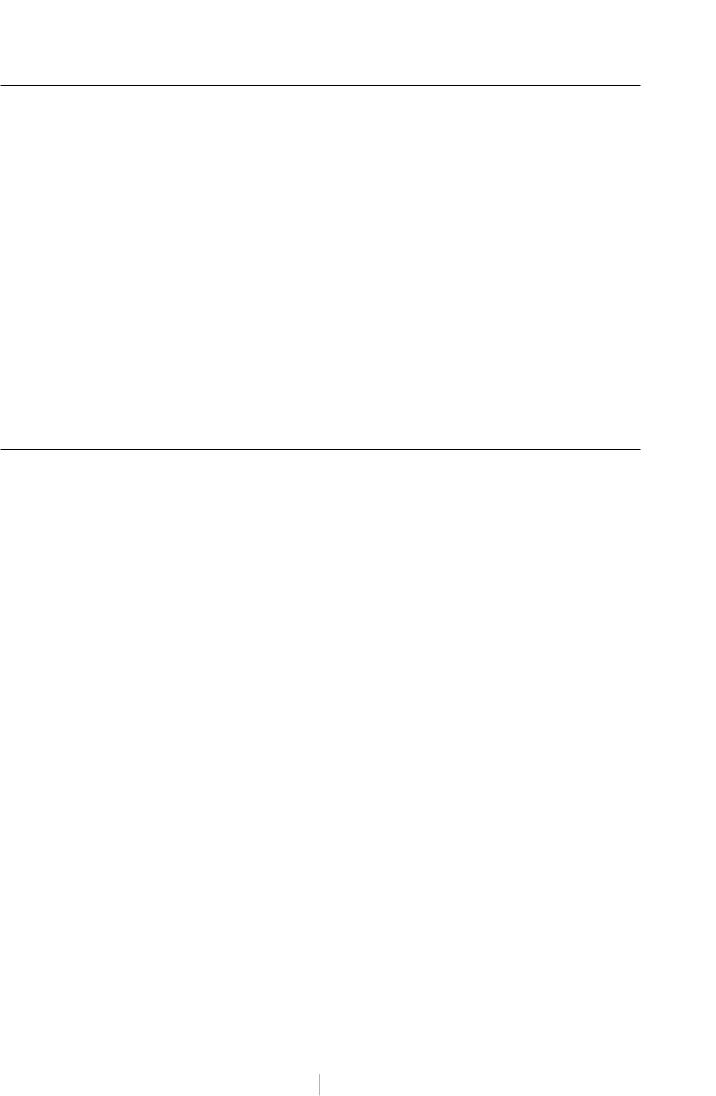
I n s t r u c t i o n m a n u a l |
VMK-149plus/VMK-188plus |
|
|
CONTINOUS CONTROLLER
Among the Midi messages (note that on/off is a Midi message) is a set of 128 “continuous controller ”messages (often abbreviated “CC ”). These are mainly used to send the movements of knobs, sliders, pedals, and so forth. For example, a synth’s modulation wheel is sending a CC message which will almost always be CC number 1. (See list below.) Each CC has a possible range of 0 –127, so when you move a mod wheel down to its rest position, it should send a CC number 1 message with a value of 0, and when you push it up to its highest point it should send a CC number 1 message with a value of 127. The VMK takes this Midi capability and puts the control in the hands of the user. All of the VMK’s knobs, sliders and pedal inputs may be programed to transmit these CC values.
Certain of the CC numbers are reserved for particular purposes. For instance, CC64 is the sustain pedal. In fact, several of the controllers (64, 65, 66, etc.) are defined as on/off switches rather than as continuous: Your sustain pedal will probably send a CC64 message with a value of 127 when pressed, and another CC64 message with a value of 0 when released. This comes into play when programing the pedal inputs. Your VMK and a sequencer or audio program can give you an almost unlimited number of routing possibilities to control the various functions of the program(s) you’re using. Check with your software manual for details specific to your need.
Common controller Numbers
1Modulation Wheel (0-127)
2Breath Controller (0-127)
4Foot Controller (0-127)
5Portamento Time (0-127)
6Data Slider (0-127)
7Main Volume (0-127)
8Balance (0-127)
10Pan (0-127)
11Expression (0-127)
16General Purpose num1 (0-127)
17General Purpose num2 (0-127)
18General Purpose num3 (0-127)
19General Purpose num4 (0-127)
64Sustain Pedal (0 or 127)
65Portamento On/Off (0 or 127)
66Sustenuto Pedal (0 or 127)
67 Soft Pedal (0 or 127)
69 Hold 2 (0 or 127)
80General Purpose num5 (0-127)
81General Purpose num6 (0-127)
82General Purpose num7 (0-127)
83General Purpose num8 (0-127)
92Tremolo Depth (0-127)
93Chorus Depth (0-127)
94Celeste (Detune) Depth (0-127)
95Phase Depth (0-127)
96Data Increment (0 or 127)
97Data Decrement (0 or 127)
121Reset all Controllers (0)
122Local Control On/Off (0 or 127)
123All Notes Off (0)
3
c o n t i n o u s c o n t r o l l e r s
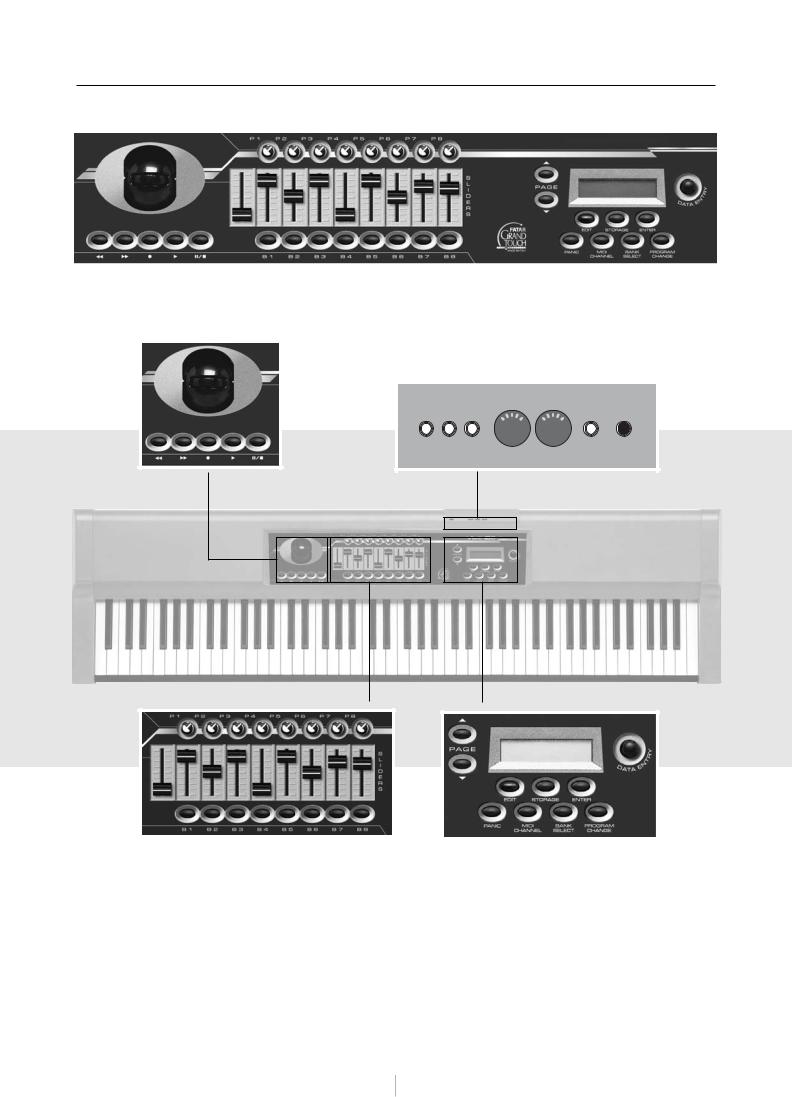
I n s t r u c t i o n m a n u a l |
VMK-149plus/VMK-188plus |
|
|
KEYBOARD LAYOUT: OVERVIEW
Full Control Panel
Joystick Transport Controls
Back Panel
PEDAL IN |
MIDI OUT |
9V POWER |
3 2 1
Knobs/Sliders/Buttons |
Live Edit Controls |
4
k e y b o a r d l a y o u t
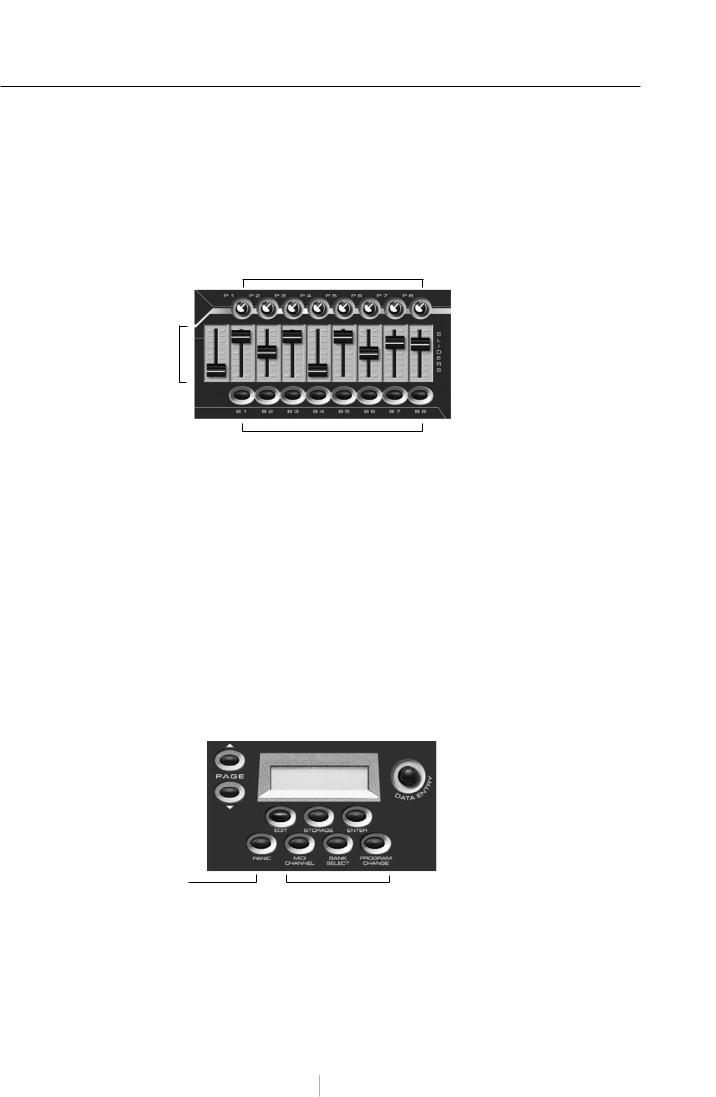
I n s t r u c t i o n m a n u a l |
VMK-149plus/VMK-188plus |
|
|
KEYBOARD LAYOUT: DETAILS
Knobs,Buttons & Sliders
Knobs,buttons, and sliders may be programmed to control anything from a loop on a sampler to reverb depth on a sound module. 8 knobs, 8 buttons, and 9 sliders are available.
knobs 1-9
sliders 1-9
buttons 1-8
Program Controls
The program control section features: A 2 x 16 Lcd display; A convenient rotary knob for data entry, referred to as the DE knob; Page up and page down buttons for moving through the various parameter options of the controller you are programming; Edit, Storage and Enter buttons, key elements when programming your keyboard; And a Panic button if all else fails.
|
|
|
LCD Display |
|||
|
|
|
|
|
|
|
|
|
|
|
|
|
|
Page UP |
|
|
|
|
|
Data Entry Knob |
Page Dn. |
|
|
|
|
|
|
|
|
|
|
|
(DE Knob) |
|
|
|
|
|
|
|
|
Panic |
Program Buttons |
NOTE: Panic will transmit a global All notes off Message.
5
k e y b o a r d l a y o u t
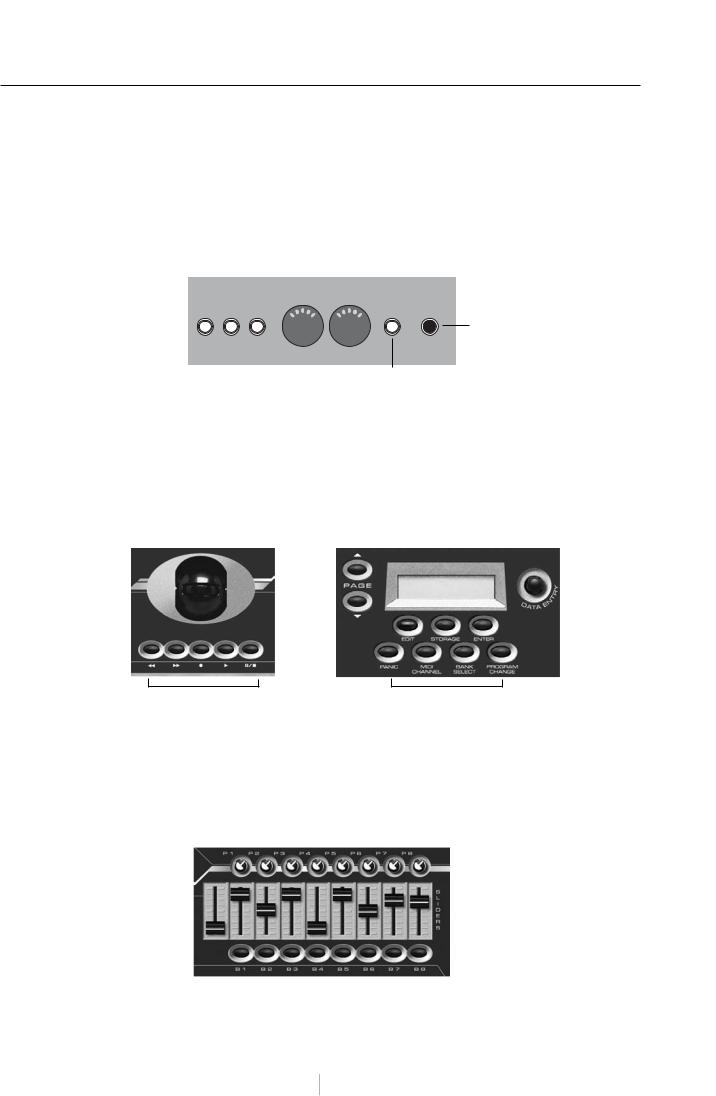
I n s t r u c t i o n m a n u a l |
VMK-149plus/VMK-188plus |
|
|
KEYBOARD LAYOUT: DETAILS
Back Panel
The back panel contains the connective parts of the keyboard: Dual Midi outputs and 3 independent foot controller inputs. The pedal inputs can accept sustain or volume pedals, each capable of sending out a completely different controller message. Pedal inputs can be programmed to accept almost any variety of manufacturers foot pedals regardless of polarity. The power adapter input and power switch are also located in the rear panel.
PEDAL IN |
MIDI OUT |
9V POWER |
Power Switch
3 2 1
Adapter In
Transport-Live Edit Controls
Transport and Live Edit controls are centrally located for quick access at a gig or in the studio. Simple but powerful, the Transport can easily be programmed to control a sequencer or a drum machine. Live Edit is indispensable for a quick program change, bank select or Midi channel change.
transport |
live edit controls |
Sliders
Sliders are perhaps the most desirable controls in a studio setting. Each of the 9 sliders may be programmed independently. They can send command specific messages, like volume, to a sound module. Or they can send control messages that may be routed through a sequencer to control various functions of the program you are running. See your program manual for details. 4 banks in total x 9 sliders gives you 36 slider commands per patch. Note: Drawbar is also a Bank.
6
l a y o u t k e y b o a r d

I n s t r u c t i o n m a n u a l |
VMK-149plus/VMK-188plus |
|
|
Preset Creation: A Summary
Preset creation is an easy process involving the use of the program controls shown in the KEYBOARD LAYOUT section of this manual.
You start by choosing a preset number using the DE knob and hitting the ENTER button. Choose a preset number higher than 3 so as not to overwrite the software presets. You can either choose an unused number or overwrite a previously written preset.
Once the preset number is selected, you hit the EDIT button to start assigning tasks to whichever controls you select. The LCD panel will tell you to Press or Move Any Controls. You may move or press a knob, a slider, a button, a keyboard key or a pedal.
The LCD will tell you what you are programming once you have moved or pressed it.
Now, you will use the Page Up or Down buttons to view the parameters available for assignment. Use the DE knob to select the parameter value you want.
When the value is selected, use the Page Up or Down buttons to move to the next parameter. When all parameters for the control have been defined, you will hit the STORAGE button and the LCD will ask if you want to store the parameters you have selected – either NO or YES.
Use the buttons underneath YES or NO to make your choice.
If you need to program additional controls for the preset, hit the EDIT button and once again you will be asked to Press or Move Any Controls. Repeat the procedure above for all the controls you desire to program for the preset you are creating.
When all the controls have been assigned to the tasks you want them to accomplish, you will have hit the STORAGE button and selected YES following the programming of the last control. The LCD screen will display a blinking cursor following Preset Num. At this time, you may name your preset (see the Preset Naming section on page 7) or decide to use only the number of the preset (4 – 30). If the number is enough, hit STORAGE again and the LCD will ask "Are You Sure?" Press the button under YES and the controller will return you to the Preset page with your preset number.
If you decide to name the preset, follow the procedure in the Preset Naming section on page 7. The last step is hitting the STORAGE button at which time the LCD will ask, "Are You Sure?" Press the button under YES and the controller will return you to the Preset page with your preset name and number.
It is essential that you remember that YOU MUST PRESS THE STORAGE BUTTON TWICE TO SAVE YOUR PRESET SETTINGS! The first time you will be asked if you want to "Store Parameters."
The all-important second time, the LCD will ask, "Are You Sure?" When you hit the YES button that time, your preset is saved.
The following Procedures will help familiarize you with the programming flexibility of the VMK-149/188.
They will show you the steps involved in assigning parameter values to the programmable controls of the keyboard. The procedures will show the ease with which you can create presets to control both studio and performance software.
7
p r e s e t c r e a t i o n
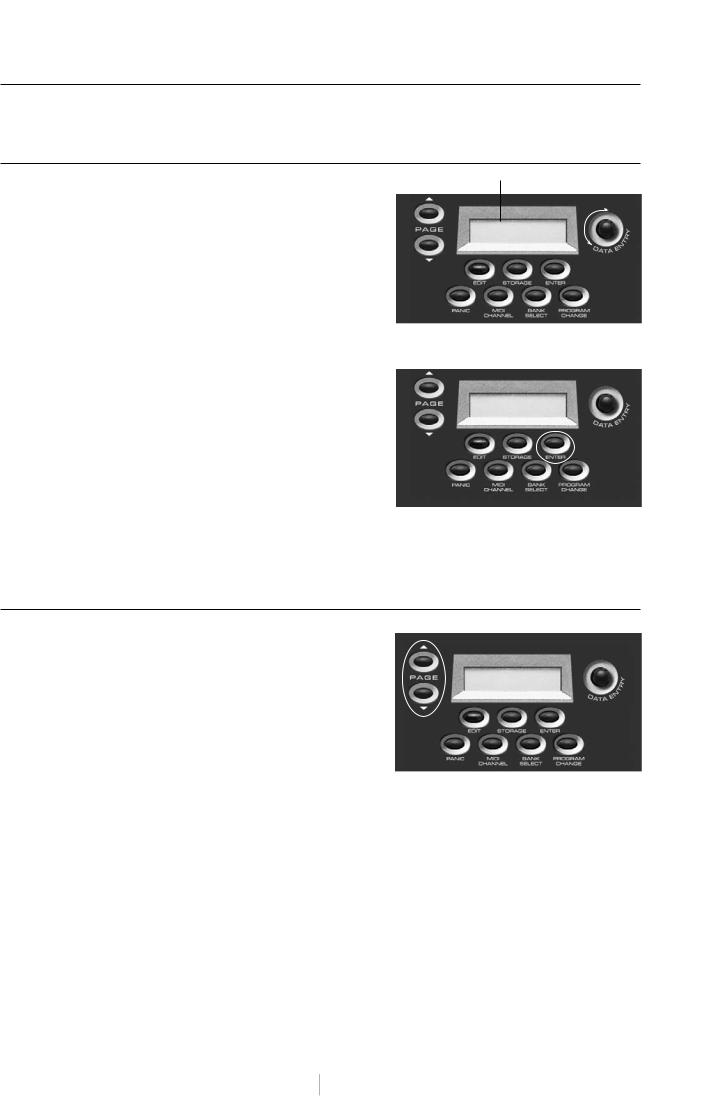
I n s t r u c t i o n m a n u a l |
VMK-149plus/VMK-188plus |
|
|
PROCEDURE: PRESET SELECTION
The VMK-149plus/188plus has 27 programmable user presets. Let’s look into the two ways of selecting a preset.
QUICK SELECT (A)
1) ROTATE DATA ENTRY KNOB
Rotating the DE Knob will scroll thru the Presets.
The cursor will blink.
Scroll to the Preset you want
2) PRESS ENTER
Wait until the cursor stops blinking. Preset is now selected.
NOTE:
You can preview the Presets without making a selection .
If you don’t Press the Enter Button. the VMK will return to the last Preset Selected.
QUICK SELECT (B)
CURSOR will blink
PRESET NUM: 1
NAME
PRESET NUM: 15
NAME
3) PRESS PAGE Up/Dn.
You may also choose Presets sequentially by using the Page up or Page down Buttons.
NOTE:
1.You must allow the VMK to scan the controls before the selection is complete;
2.You can only move thru the Presets one at a time.
PRESET NUM: 1 NAME
PROCEDURE: PRESET NAMING
Your VMK has 27 programmable user presets. Each Preset can have a 10 character name. Each name can have any combination of letters or numbers you choose. In this example, we will start from a preset that’s already been programmed. You have the option of naming your preset during the editing process. When you’ve completed your edits and reach the press storage step (Step 6 in Button Programming, Step 7 in Sliders/Knobs/Pedals, Step 8 in Keyboard), follow this procedure:
8
p r e s e t s

I n s t r u c t i o n m a n u a l
1) PRESS STORAGE
You will save your program to a user preset. Storage and Enter buttons now
function as No or Yes buttons.
NOTE:
If you select No you’ll
be taken back to the “Press or move any Control” Page.
VMK-149plus/VMK-188plus
SCREEN |
STORE PARAMETERS |
CHANGE |
NO YES |
2) PRESS ENTER (Yes)
In this example we’ll choose Yes.
NOTE:
If you’d like to move to a different Preset location use the DE knob.
THIS WILL COPY ALL
PROGRAM DATA TO
THE NEW PRESET LOCATION
STORE PARAMETERS NO YES
3) PRESS PG UP/ PG DN
By pressing the Page Up or the Page Down button you will move the cursor to the Name field of the LCD display.
|
CURSOR will blink |
|
|
|
|
|
|
|
|
|
|
|
|
|
SCREEN |
PRESET |
|
|
NUM: |
1 |
|||||||||
|
||||||||||||||
NAME |
|
|
|
|
|
|
|
|
|
|
|
|||
|
|
|
|
|
|
|||||||||
CHANGE
4) NAME PRESET
Name the Preset using the combination of The Page Buttons and the DE Knob. Remember the Name can only be
ten characters long
Page UP: moves cursor Right Page DN: moves cursor Left
Data Entry Dial: selects Letter or Number
PRESET NUM: |
1 |
||||||||||
NAME |
|
|
|
|
|
|
|
|
|
|
|
|
|
|
|
|
|
||||||
CURSOR Moves to second LCD line
Select: Letter / Number
5) PRESS STORAGE
You will save your program and its name.
PRESET NUM: |
1 |
||||||||||
NAME |
|
|
|
|
|
|
|
|
|
|
|
|
|
|
|
|
|
||||||
6) PRESS ENTER (YES)
SCREEN
You will return to the Preset Page CHANGE with your Named Preset.
ARE YOU SURE
NO YES
9
p r e s e t s

I n s t r u c t i o n m a n u a l |
VMK-149plus/VMK-188plus |
|
|
PROCEDURE: KEYBOARD PROGRAMMING
The VMK-149plus/188plus can store 27 user programmable patches. Not only does each patch contain programming information for buttons, sliders, knobs and pedals, the KEYBOARD itself, as a controller, can be customized. Each Patch can contain MIDI Channel, Aftertouch, Transpose, Program Change and Bank Select information.
1) PRESS EDIT
SCREEN
CHANGE
PRESS OR MOVE
ANY CONTROLS
2) PRESS KEY |
To adjust the Midi Channel use the DE knob. |
|
|
You may Press any key
on the Keyboard.
SCREEN
CHANGE
KEYBOARD EDIT
MIDI CHANNEL: OFF
3) PRESS PAGE UP
Within each Patch a Bank Select High message can be sent.
See your sound source manufacturer’s manual for details.
To adjust the Bank Select Hi value use the DE knob.
SCREEN |
KEYBOARD EDIT |
CHANGE |
BANK SEL. HI: 0 |
To adjust the Bank Select Lo use the DE knob.
4) PRESS PAGE UP
Within each Patch a Bank Select Low message can be sent.
See your sound source manufacturer’s manual for details.
SCREEN |
KEYBOARD EDIT |
CHANGE |
BANK SEL. LO: 0 |
To adjust the Program Change Value use the DE knob.
5) PRESS PAGE UP
You have the option to send out a Program Change within the Patch.
SCREEN |
KEYBOARD EDIT |
CHANGE |
PROG CHANGE: 0 |
10
k e y b o a r d

I n s t r u c t i o n m a n u a l |
VMK-149plus/VMK-188plus |
|
|
6) PRESS PAGE UP |
|
To adjust the Transpose value use the DE knob |
|
Transpose can be adjusted |
|
|
|
from 0 to +24 or 0 to -24 |
SCREEN |
KEYBOARD EDIT |
|
|
|
||
|
CHANGE |
TRANSPOSE:+ |
0 |
To adjust the After Touch value use the DE knob
7) PRESS PAGE UP
You have the option to program After Touch on or off for each Patch.
KEYBOARD EDIT SCREEN AFTER TOUCH: ON
CHANGE
6) PRESS STORAGE
You have the option to program After Touch on or off for each Patch.
SCREEN |
STORE PARAMETERS |
CHANGE |
NO YES |
NOTE:
Storage and Enter buttons now function as No and Yes buttons.
SCREEN |
STORE PARAMETERS |
CHANGE |
NO YES |
7) PRESS ENTER (Yes)
SCREEN
CHANGE
In this example we’ll choose Yes.
PRESET NUM.: 1 NAME: 











8) PRESS STORAGE
The blinking cursor indicates |
SCREEN |
|
preset number selection. |
||
CHANGE |
||
|
ARE YOU SURE?
NO YES
11
k e y b o a r d
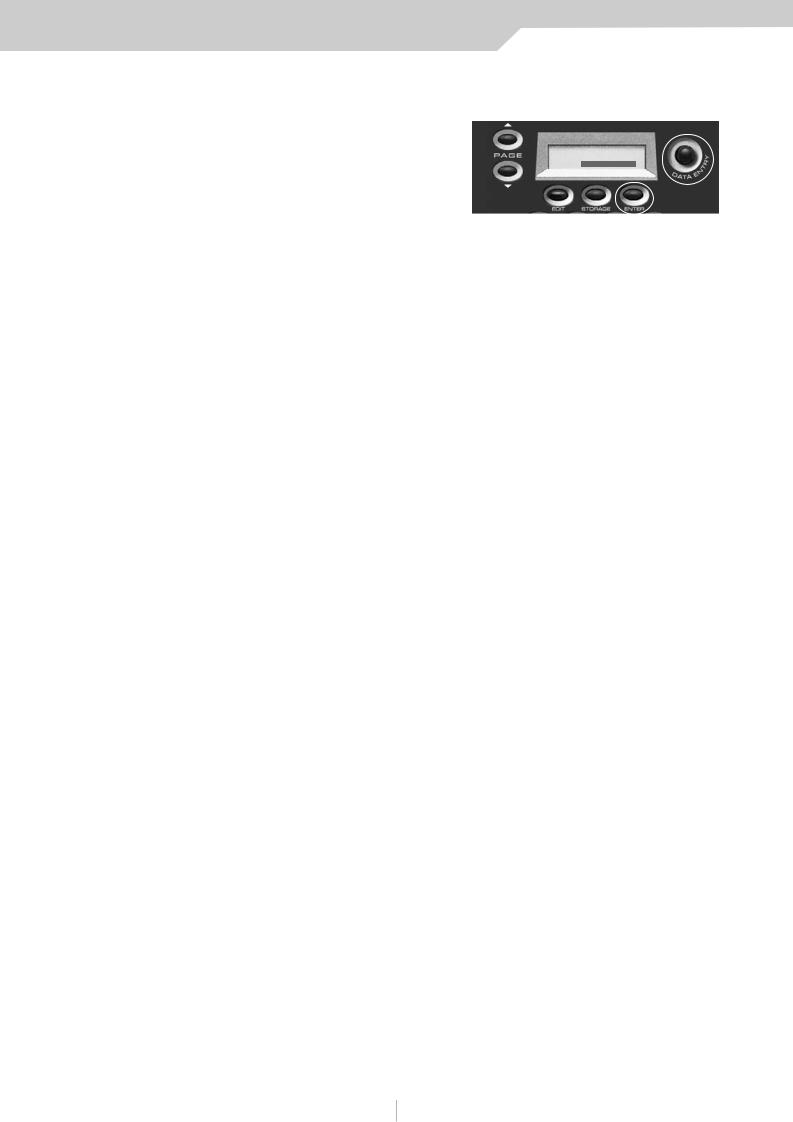
I n s t r u c t i o n m a n u a l
9) PRESS ENTER (Yes)
Wait for the keyboard to Scan Controls.
You will now return to the
Preset page.
VMK-149plus/VMK-188plus
SCREEN |
PRESET NUM.: 1 |
CHANGE |
NAME: |
12
k e y b o a r d

I n s t r u c t i o n m a n u a l |
VMK-149plus/VMK-188plus |
|
|
PROCEDURE: SLIDER / KNOB PROGRAMMING
We will set up a SLIDER to behave like an analog mixer fader. Fader Down>min. volume. Fader Up>Max. Vol. Programing KNOBS follows the Exact same procedure.
TIP: Unlike an analog mixer you might not want your minimum volume to be 0 (no sound). You may just want a track to “sit” in the mix. Therefore you should choose a value greater than 0. For example, you may want to “ride” a guitar part and not want its volume to dip below a certain level in the mix. In that case set the Min. to a value that sounds good. Then when you pull the fader down you’ll still hear the guitar without having to worry about fader position. You can reverse this example for Max Values also.
1) PRESS EDIT
SCREEN
CHANGE
PRESS OR MOVE
ANY CONTROLS
2) MOVE SLIDER (KNOB)
In this example Move SLIDER 1 w/Bank A Selected
(Remember: keep track of
your BANKS when programing!)
To adjust the Midi Channel use the DE knob
SCREEN |
EDIT SLIDER |
51 |
CHANGE |
MIDI CHANNEL |
OFF |
Move SLIDER (1)
3) PRESS PAGE UP
In this example we’ll use
CTRL Change number 10. You may adjust this to any CTRL number you desire.
To adjust the CTRL Change use the DE knob
SCREEN |
EDIT SLIDER: |
51 |
CHANGE |
CTRL CHANGE: |
10 |
To adjust the Value Min. use the DE knob
4) PRESS PAGE UP
Set the Value Min. to 0 |
|
|
SCREEN |
EDIT SLIDER: |
51 |
CHANGE |
VALUE MIN.: |
0 |
5) PRESS PAGE UP
Set the Value Max to 127
In this example when the Slider is pushed UP it will increase to the Maximum allowed
To adjust the Value Max use the DE knob
SCREEN |
EDIT SLIDER: |
51 |
CHANGE |
VALUE MAX: |
127 |
13
s l i d e r s / k n o b s
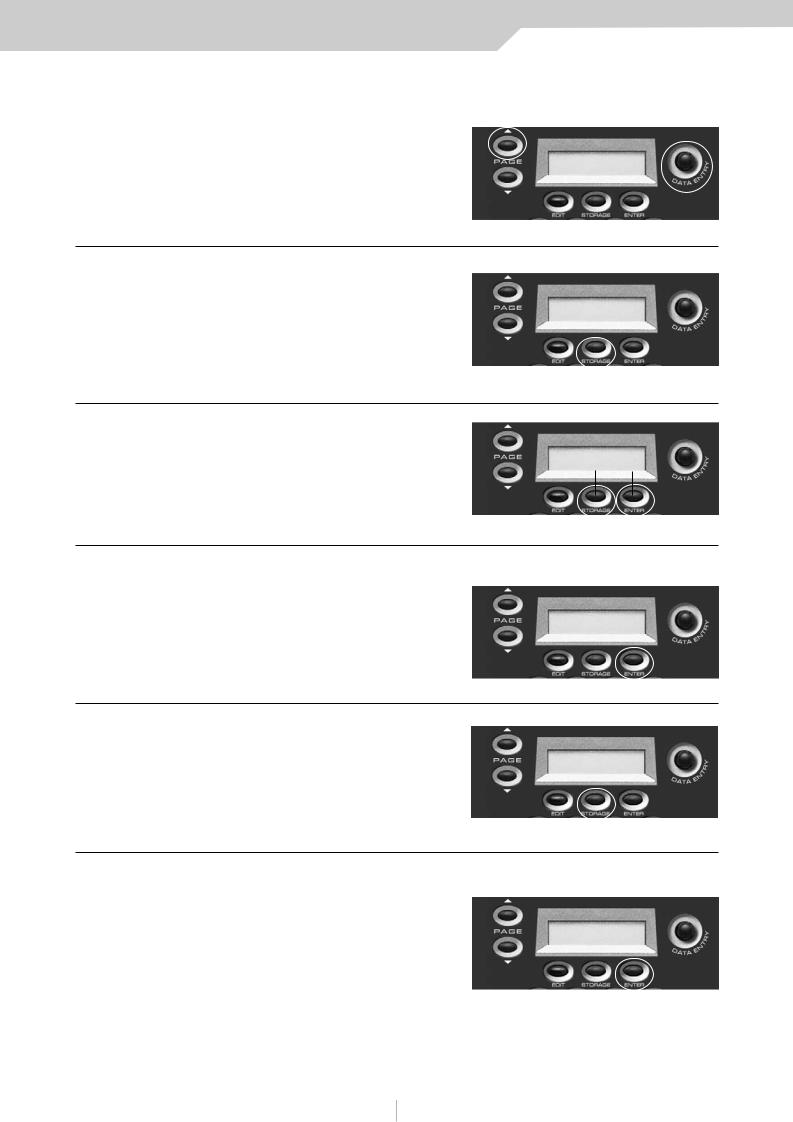
I n s t r u c t i o n m a n u a l
6) PRESS PAGE UP
In this example select DN>UP When the Slider is in the DOWN position it will send a Value of O when UP a Value of 127.
VMK-149plus/VMK-188plus
To adjust the Polarity value use the DE knob
SCREEN |
EDIT SLIDER: |
51 |
CHANGE |
POLARITY: |
DN>UP |
7) PRESS STORAGE
You are now going to save your program to a user preset.
SCREEN |
STORE PARAMETER |
CHANGE |
NO YES |
NOTE:
Storage and Enter buttons now function as No and Yes buttons.
STORE PARAMETER NO YES
CURSOR will blink
8) PRESS ENTER (Yes)
In this example we’ll choose Yes.
SCREEN |
PRESET NUMBER: 1 |
||||||||||||||||||||||||
CHANGE |
NAME: |
|
|
|
|
|
|
|
|
|
|
|
|
|
|
|
|
|
|
|
|
|
|
|
|
|
|
|
|
|
|
|
|
|
|
|
|
||||||||||||||
|
|
|
|
|
|
|
|
|
|
|
|
||||||||||||||
9) PRESS STORAGE
The blinking cursor indicates |
SCREEN |
|
preset number selection. |
||
CHANGE |
||
|
ARE YOU SURE?
YES NO
10) PRESS ENTER (Yes)
You will now return to the Preset page.
You have completed your first programing session! You will have to repeat these steps in order to program more sliders and knobs.
SCREEN |
PRESET NUMBER: 1 |
||||||||||||||||||||||||
CHANGE |
NAME: |
|
|
|
|
|
|
|
|
|
|
|
|
|
|
|
|
|
|
|
|
|
|
|
|
|
|
|
|
|
|
|
|
|
|
|
|
||||||||||||||
|
|
|
|
|
|
|
|
|
|
|
|
||||||||||||||
14
s l i d e r s / k n o b s

I n s t r u c t i o n m a n u a l |
VMK-149plus/VMK-188plus |
|
|
PROCEDURE: BUTTON PROGRAMMING
We will set up a BUTTON to behave like a simple ON/OFF switch, or Latch Switch. Press the BUTTON once and the Switch will be on. Press the BUTTON again and the Switch will be off. Programming Transport BUTTONS follows the exact same procedure.
TIP: This can be very useful to control the Mutes on your Audio/Sequencing program. Most Pro and Semi Pro Audio/Sequencing programs will allow you the option to control various functions of the program from an external controller, in this example, controlling the Mutes on your virtual mixer. (See your Program’s manual for details.) Each BUTTON can behave like a Latch, used in this Mute example (SWITCH MODE), or like a Momentary (PUSH MODE) switch. A Momentary switch will only function when the BUTTON is held down. This is very useful for the Fwd BUTTON and Rew BUTTON in the Transport section.
1) PRESS EDIT
SCREEN
CHANGE
PRESS OR MOVE
ANY CONTROLS
2) PRESS BUTTON
In this example Move SLIDER 1
w/Bank A Selected |
To adjust the Midi Channel use the DE knob |
|||
(Remember: keep track of |
|
|
|
|
your BANKS when programing!) |
|
|
|
|
|
SCREEN |
EDIT |
SLIDER |
51 |
|
||||
|
||||
|
CHANGE |
MIDI |
CHANNEL |
OFF |
Press BUTTON (1)
3) PRESS PAGE UP
In this example we’ll use
CTRL Change number 10. You may adjust this to any CTRL number you desire.
To adjust the CTRL Change use the DE knob
SCREEN |
EDIT BUTTON: |
B1 |
CHANGE |
CTRL CHANGE: |
OFF |
To adjust the Key Note use the DE knob
4) PRESS PAGE UP |
|
Set the Key Note to 60. |
SCREEN |
Key range is 0-127 |
CHANGE |
|
EDIT BUTTON: B1
CTRL CHANGE: OFF
5) PRESS PAGE UP
SWITCH: Press button once,
a NOTE ON Message will transmit. Switch is ON.
Press button again, a NOTE OFF Message will transmit.
Switch is OFF.
To adjust the Key Note use the DE knob
SCREEN |
EDIT BUTTON: B1 |
CHANGE |
KEY NOTE: SWITCH |
15
b u t t o n s
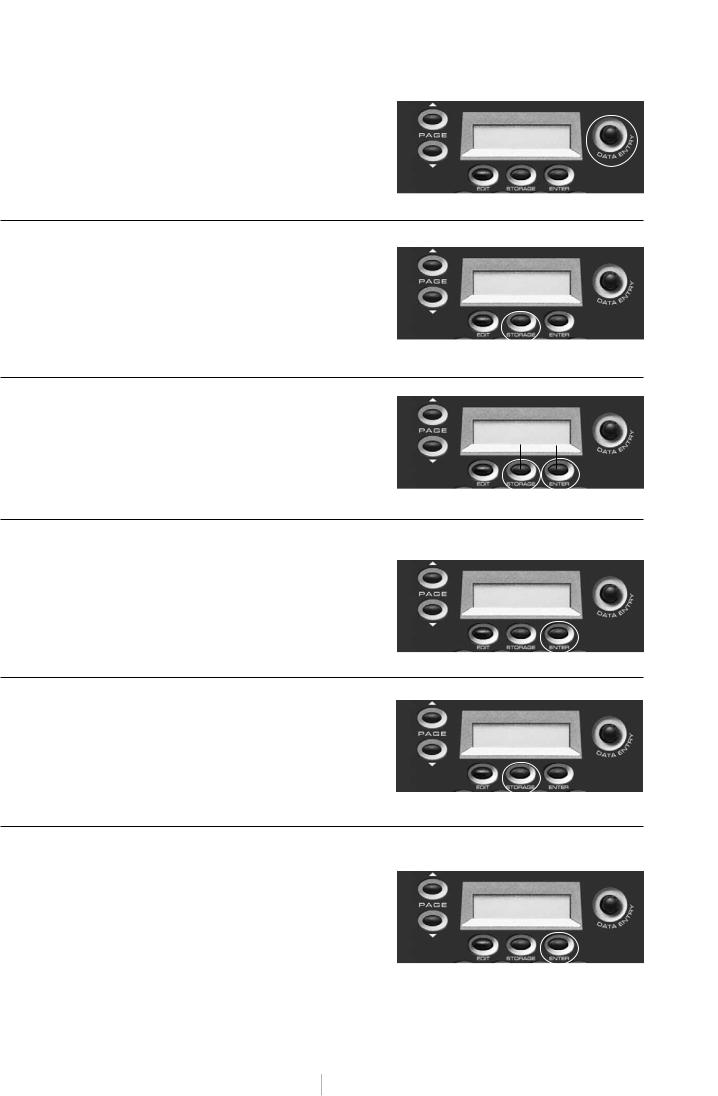
I n s t r u c t i o n m a n u a l |
VMK-149plus/VMK-188plus |
|
|
5) continued...
PUSH: will send a Note on Message when pushed down. When you release the button, a Note off Message will be sent.
The BUTTON will only work when you are actually Pushing it down.
To adjust the Key Mode use the DE knob
SCREEN |
EDIT BUTTON: |
B1 |
CHANGE |
KEY MODE: |
PUSH |
6) PRESS STORAGE
You are now going to save your program to a user preset.
SCREEN |
STORE PARAMETER |
CHANGE |
NO YES |
NOTE:
Storage and Enter buttons now function as No and Yes buttons.
STORE PARAMETER NO YES
CURSOR will blink
7) PRESS ENTER (Yes)
In this example we’ll choose Yes.
SCREEN |
PRESET NUMBER: 1 |
||||||||||||||||||||||||
CHANGE |
NAME: |
|
|
|
|
|
|
|
|
|
|
|
|
|
|
|
|
|
|
|
|
|
|
|
|
|
|
|
|
|
|
|
|
|
|
|
|
||||||||||||||
|
|
|
|
|
|
|
|
|
|
|
|
||||||||||||||
8) PRESS STORAGE
The blinking cursor indicates |
SCREEN |
|
preset number selection. |
||
CHANGE |
||
|
ARE YOU SURE?
NO YES
9) PRESS ENTER (Yes)
Wait for the keyboard to Scan Controls.
You will now return to the |
SCREEN |
CHANGE |
|
Preset page. |
|
You will have to repeat these |
|
steps in order to program |
|
more buttons. |
|
PRESET NUMBER: 1 NAME: 











16
b u t t o n s

I n s t r u c t i o n m a n u a l |
VMK-149plus/VMK-188plus |
|
|
PROCEDURE: PEDAL PROGRAMMING
We will program PEDAL INPUT 1 to transmit Sustain. For this procedure you will need a Sustain Pedal. Any polarity pedal will work.
TIP: The three PEDAL INPUTS may be programed to transmit anything from Sustain to Volume to even Modulation. A PEDAL INPUT, when connected to a Volume Pedal , can transmit the same CNTRL Values as the SLIDERS or KNOBS. Remember, you have three PEDAL INPUTS to work with. Imagine in a live set-up, two volume pedals set-up to control two different sounds. In our set-up you would program PEDAL 1 so its Polarity would be DN>UP, and PEDAL 2 so it’s Polarity would be UP>DN. By pressing down on both volume pedals, you would fade out of one sound and fade into the other! All without awkward foot movement.
1) PRESS EDIT
SCREEN
CHANGE
PRESS OR MOVE
ANY CONTROLS
2) PRESS PEDAL
In this example set the Midi Channel to 1
Remember: the sustain Pedal must be plugged into PEDAL INPUT 1
To adjust the Midi Channel use the DE knob
SCREEN |
EDIT PEDALS: |
-1- |
CHANGE |
MIDI CHANNEL |
OFF |
3) PRESS PAGE UP
We need to set the
CTRL Change to 64
That's the Midi Spec for Sustain Pedal.
To adjust the CTRL Change use the DE knob
SCREEN |
EDIT PEDALS: |
-1- |
CHANGE |
CTRL CHANGE |
64 |
To adjust the Value Min. use the DE knob
4) PRESS PAGE UP
Set the Value Min. to 0
In this case any Value below
<64 will transmit an off Message.
SCREEN |
EDIT PEDALS: |
-1- |
CHANGE |
VALUE MIN: |
0 |
To adjust the Value Max use the DE knob
5) PRESS PAGE UP |
|
Set the Value Max to 127 |
SCREEN |
In this case any Value above |
CHANGE |
>64 will transmit an on Message. |
|
EDIT PEDALS: -1-
VALUE MAX: 127
17
p e d a l s

I n s t r u c t i o n m a n u a l
6) PRESS PAGE UP
This is where the flexibility of the VMK comes into play. You can adjust the Polarity to the Pedal that’s being used. If there’s sustain without the Pedal being depressed just adjust
the Polarity on the VMK to fit the pedal.
VMK-149plus/VMK-188plus
To adjust the Polarity value use the DE knob
SCREEN |
EDIT PEDALS: |
-1- |
CHANGE |
POLARITY: |
DN>UP |
7) PRESS STORAGE
You are now going to save your program to a user preset.
SCREEN |
STORE PARAMETER |
CHANGE |
NO YES |
NOTE:
Storage and Enter buttons now function as No and Yes buttons.
STORE PARAMETER NO YES
CURSOR will blink
8) PRESS ENTER (Yes) |
|
In this example we’ll choose Yes. |
SCREEN |
|
CHANGE |
PRESET NUMBER: 1 NAME: 











9) PRESS STORAGE
SCREEN
The blinking cursor indicates CHANGE preset number selection.
ARE YOU SURE?
NO YES
10)PRESS ENTER (Yes)
You will now return to the Preset page.
You will have to repeat these steps in order to program more pedals.
SCREEN |
PRESET NUMBER: 1 |
||||||||||||||||||||||||
CHANGE |
NAME: |
|
|
|
|
|
|
|
|
|
|
|
|
|
|
|
|
|
|
|
|
|
|
|
|
|
|
|
|
|
|
|
|
|
|
|
|
||||||||||||||
|
|
|
|
|
|
|
|
|
|
|
|
||||||||||||||
18
p e d a l s

I n s t r u c t i o n m a n u a l |
VMK-149plus/VMK-188plus |
|
|
PROCEDURE: LIVE EDIT
The ability to quickly send a Program Change or Bank Select change or change the Midi Channel without altering the original Preset program.
In this example you will send a quick Program Change to your sound source. Sending a Bank Change or changin the Midi Channel, follows the EXACT same procedure. Although you will select those options in step 1.
START FROM A PROGRAM
PRESET NUMBER: 1
NAME:
To adjust the Program Change value use the DE knob
1) PRESS PROGRAM CHANGE
You can press Midi Channel or Bank Select if those are
the Messages you want to send SCREEN
CHANGE
2) PRESS ENTER
You will now return to the Preset page.
That’s it! Live Edit is an extremely easy but powerful function of
the VMK-149plus/VMK-188plus.
PRESET NUMBER: 1
NAME:
SCREEN
CHANGE
19
l i v e e d i t

m a n u a l e d i i s t r u z i o n e |
VMK-149plus/VMK-188plus |
|
|
INTRODUZIONE AL VMK |
21 |
CONTROLLER CONTINUI |
22 |
CONFIGURAZIONE DELLA TASTIERA |
23-25 |
CREAZIONE DI PRESET: DESCRIZIONE RIASSUNTIVA |
26 |
PROCEDURE: |
|
SELEZIONE E IDENTIFICAZIONE DEI PRESET |
27-28 |
PROGRAMMAZIONE DELLA TASTIERA |
29-31 |
PROGRAMMAZIONE DEI CURSORI |
|
E DEI POTENZIOMETRI |
32-33 |
PROGRAMMAZIONE DEI PULSANTI |
34-35 |
PROGRAMMAZIONE DEL PEDALE |
36-37 |
LIVE EDIT |
38 |

m a n u a l e d i i s t r u z i o n e |
VMK-149plus/VMK-188plus |
|
|
INTRODUZIONE AL VMK
Benvenuti nel meraviglioso mondo della serie VMK Studiologic!
I VMK sono tastiere controller programmabili a più livelli. Il VMK-149 è la prima tastiera al mondo con 49 tasti completamente pesati, e il VMK-188 ha una tastiera di 88 note. Entrambi sono dotati del famoso tasto azione FATAR. Funzionalmente, essi sono identici ad eccezione del numero dei tasti. Entrambe le unità dispongono di pitch bend (regolazione del tono), aftertouch (risposta al tocco naturale), “on the fly” live edit (espressività della funzione editor), potenziometri, pulsanti e cursori assegnabili e 2 input a pedale indipendenti e totalmente programmabili.
Guardate soltanto ciò che è possibile assegnare loro:
•8 potenziometri programmabili X 2 banchi;
•8 pulsanti programmabili X 2 banchi;
•9 cursori programmabili X 4 banchi;
•una sezione trasporto programmabile dotata di 5 pulsanti;
•e 3 input a pedale programmabili.
Tutto questo per un totale di 77 controlli assegnabili!
Le VMK sono tastiere professionali con capacità di superficie di controllo incorporata. Si tratta di tastiere MIDI a superficie di controllo con 3 programmi preset, 29 patches di aggiornamento programmabili dall’utente e una imbattibile combinazione di potenziometri, pulsanti, cursori e pedali. Essi permettono di modificare a piacimento ogni vostra session musicale. Il tutto tenendo in particolare considerazione l’aspetto economico.
Caratteristiche Principali:
•VMK-149: 49 tasti a grandezza naturale con azione pesata
•VMK-188: 88 tasti a grandezza naturale con azione pesata
CARATTERISTICHE COMUNI AD ENTRAMBE LE UNITÀ:
•SENSIBILE AL TOCCO
•AFTERTOUCH PROGRAMMABILE
•PITCH BEND
•CAMBIO DEL PROGRAMMA/SELEZIONE DEL BANCO/CANALE MIDI
•9 CURSORI PROGRAMMABILI
•8 POTENZIOMETRI PROGRAMMABILI
•8 PULSANTI PROGRAMMABILI
•8 PULSANTI PROGRAMMABILI PER IL CONTROLLO DEL TRASPORTO•
•3 PEDALI INPUT PROGRAMMABILI
•3 PROGRAMMI PRESET:
1- NATIVE INSTRUMENT B4;
2- STEINBERG CUBASE;
3- NATIVE INSTRUMENT PRO 53
•27 PATCHES PROGRAMMABILI DALL’UTENTE
•DUPLICE OUTPUT MIDI
•BORSA PORTA TASTIERA E PEDALE FOOTSWITCH INCLUSI
21
i n t r o d u z i o n e a l V M K

m a n u a l e d i i s t r u z i o n e |
VMK-149plus/VMK-188plus |
|
|
CONTROLLER CONTINUI
Tra i messaggi Midi (nota che on/off è un messaggio Midi) c’è un gruppo di 128 messaggi “Controller Continui” (spesso abbreviati “CC”). Questi sono utilizzati principalmente per inviare i movimenti ai potenziometri, ai cursori, ai pedali e così via. Per esempio, una ruota di modulazione di un sintetizzatore che stia inviando un messaggio CC sarà quasi sempre un CC numero 1. (Vedi l’elenco che segue). Ogni CC presenta una possibile gamma da 0 a 127, così quando muovete in basso una ruota di modulazione fino alla sua posizione di riposo, essa dovrebbe inviare un messaggio CC numero 1 con un valore 0, e quando invece la spingete in alto fino al suo punto massimo, dovrebbe inviare un messaggio CC numero 1 con un valore di 127. Il VMK fa propria questa capacità MIDI e ne affida il controllo direttamente nelle mani dell’utente. Tutti gli input dei potenziometri, dei cursori e dei pedali possono essere programmati per trasmettere questi valori CC. Alcuni numeri CC sono riservati a scopi particolari. Per esempio, il CC64 è il pedale sustain. Infatti diversi controller (64, 65, 66 ecc.) sono definiti piuttosto come switch on/off (interruttori acceso/spento) che come continui: il vostro pedale sustain probabilmente invierà un messaggio CC64 con un valore di 127 ogni volta che sarà premuto, e un altro messaggio CC64 con un valore di 10 quando sarà rilasciato. Ciò è da tenere in considerazione quando si programmano gli input del pedale. Il vostro VMK e un ordinatore di sequenza o un programma audio possono darvi un numero pressoché illimitato di possibilità di instradamento per controllare le varie funzioni del programma (o dei programmi) che state utilizzando. Sul manuale del software troverete informazioni più dettagliate relativamente alle vostre specifiche esigenze.
Numeri Comuni di Controller
1 Ruota di modulazione (0-127)
2 Breath (0-127)
4 Pedale (0-127)
5 Tempo di portamento (0-127)
6 Cursore Dati (0-127)
7 Volume principale (0-127)
8 Balance (0-127)
10 Panoramico (0-127)
11 Espressione (0-127)
16 Generale # 1 (0-127)
17 Generale # 2 (0-127)
18 Generale # 3 (0-127)
19 Generale # 4 (0-127)
64 Pedale Sustain (0 oppure 127)
65 Portamento On/off (0 oppure 127)
66 Pedale Sostenuto (0 oppure 127)
67 Pedale Leggero (0 oppure 127)
69 Hold 2 (0 oppure 127)
80 Generale # 5 (0-127)
81 Generale # 6 (0-127)
82 Generale # 7 (0-127)
83 Generale # 8 (0-127)
92 Profondità di Tremolo (0-127)
93 Profondità di Corus (0-127)
94 Profondità Detune (0-127)
95 Profondità Phase (0-127)
96 Aumento Dati (0 oppure 127)
97 Diminuzione Dati (0 oppure 127)
121 Reset di tutti i controller (0)
122 Controlli Locali On/Off (0 oppure 127)
123 Tutte le Note Off (0)
22
c o n t r o l l e r c o n t i n u i
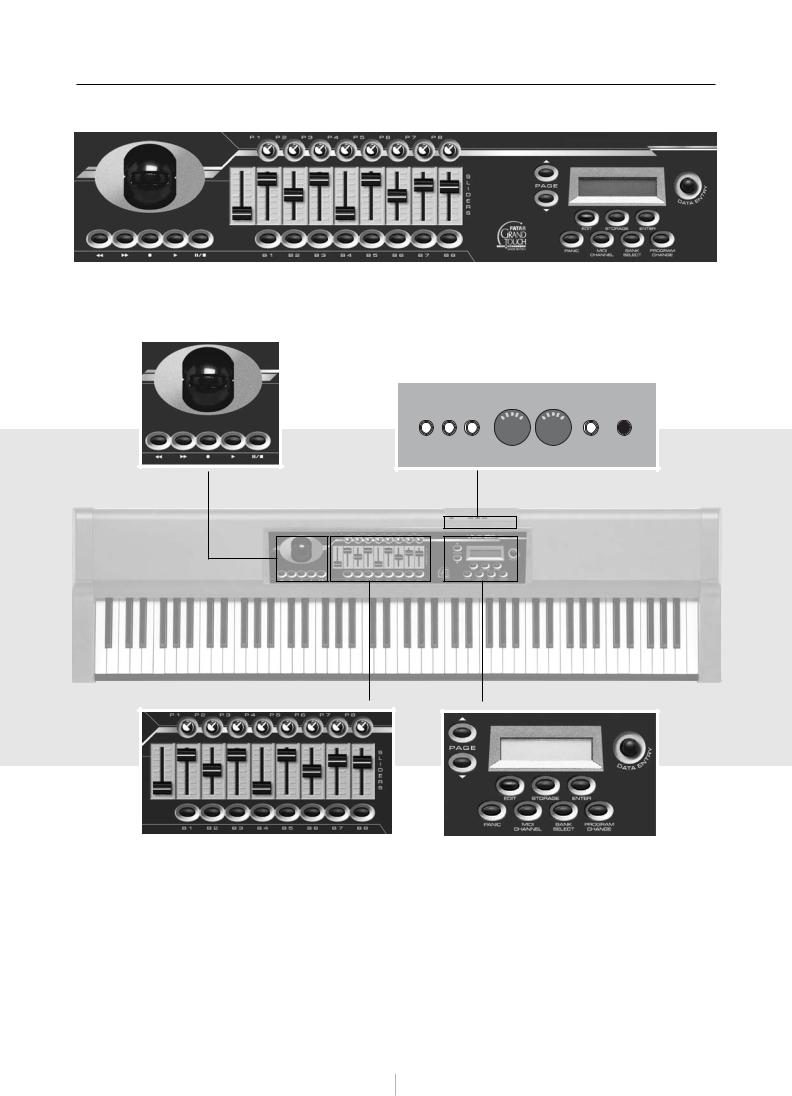
I n s t r u c t i o n m a n u a l |
VMK-149plus/VMK-188plus |
|
|
CONFIGURAZIONE DELLA TASTIERA: IN GENERALE
Pannello di controllo generale
Joystick Controlli di Trasporto
Retro del Pannello
PEDAL IN |
MIDI OUT |
9V POWER |
3 2 1
Potenziometri/Cursori/Pulsanti |
Controlli Live Edit |
23
c o n f i g u r a z i o n e t a s t i e r a
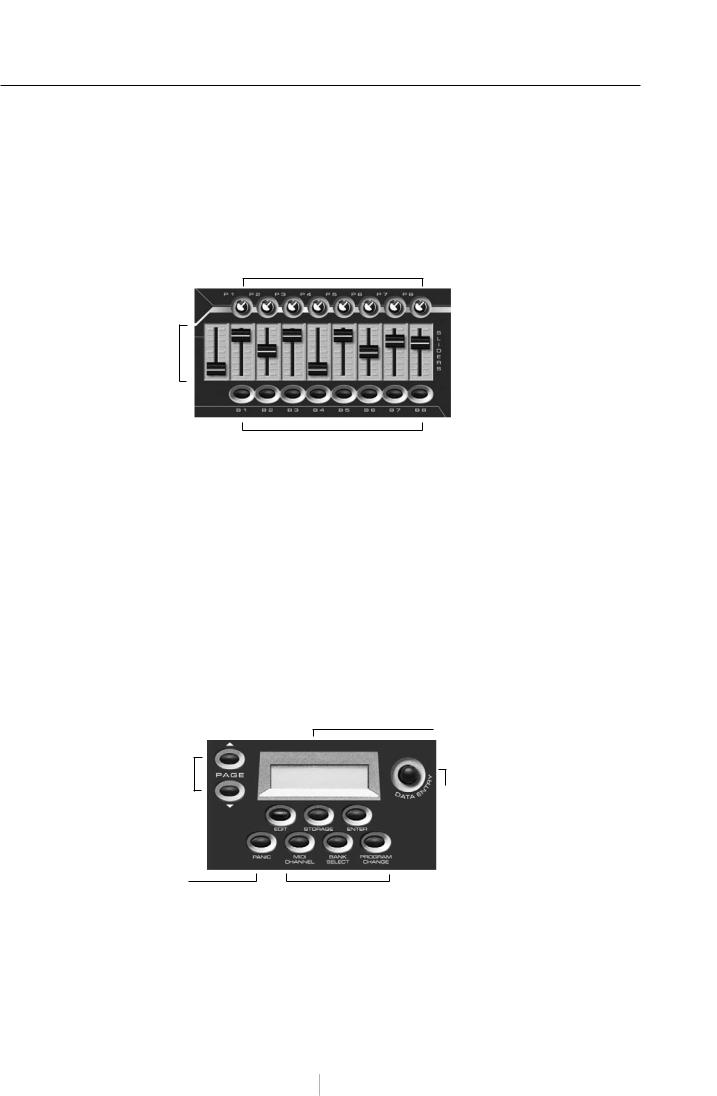
m a n u a l e d i i s t r u z i o n e |
VMK-149plus/VMK-188plus |
|
|
CONFIGURAZIONE DELLA TASTIERA: IN DETTAGLIO
Potenziometri, Pulsanti & Cursori
Potenziometri, pulsanti e cursori possono essere programmati per controllare qualsiasi cosa, da un collegamento su un campionatore fino ad amplificare la profondità di un sound module. Sono disponibili 8 potenziometri, 8 pulsanti e 9 cursori.
potenziometri 1-9
sliders 1-9
pulsanti 1-8
Controlli di Programma
La sezione controllo programma ha le seguenti caratteristiche: A2 X 16 display Lcd; un utile potenziometro a manopola rotante per la voce dati, che è chiamato “potenziometro DE”; pulsanti Page up/down per muoversi attraverso le varie opzioni di parametro del controller che state programmando; i pulsanti Edit (elaborazione), Storage (memorizzazione) e Enter (conferma) che sono elementi chiave quando programmate la vostra tastiera; e un pulsante Panic se sbagliate qualcosa.
Page UP
Page Dn.
Panic
Nota: Panic trasmetterà un messaggio di annullamento
di tutte le note.
LCD Display
Pulsanti Programma
Potenziometro
Voce Dati
(potenziometro DE)
24
c o n f i g u r a z i o n e t a s t i e r a
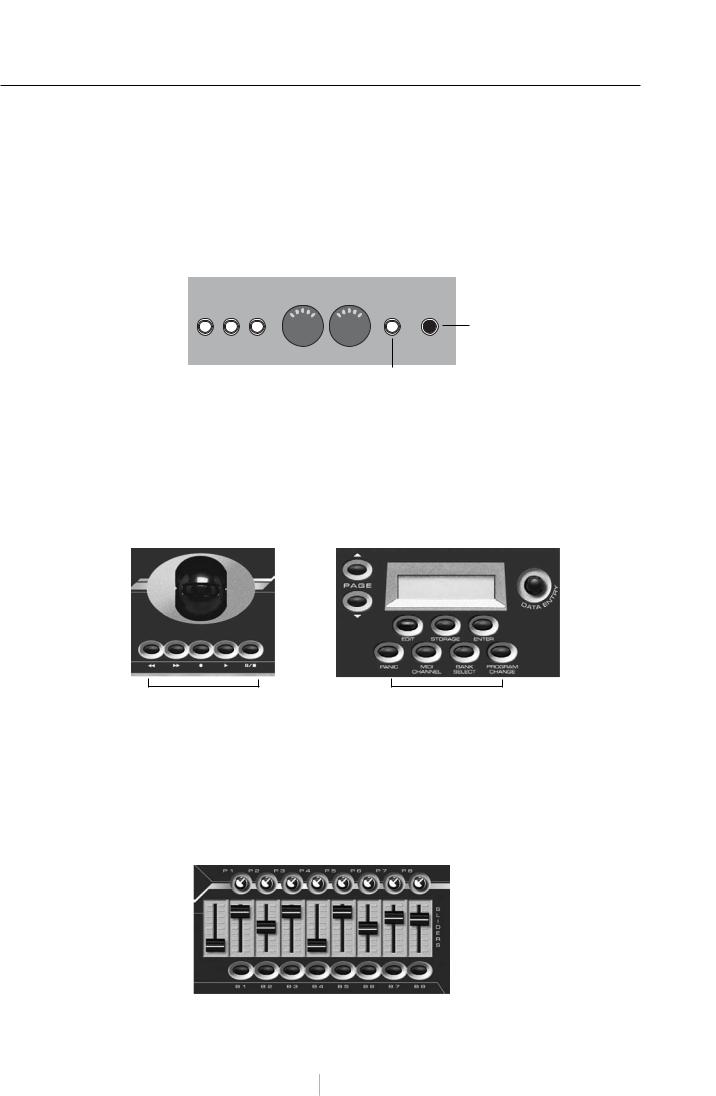
m a n u a l e d i i s t r u z i o n e |
VMK-149plus/VMK-188plus |
|
|
CONFIGURAZIONE DELLA TASTIERA: IN DETTAGLIO
Pannello posteriore
Il pannello posteriore contiene le parti connettive della tastiera: il duplice output MIDI e 3 input a pedale indipendenti. Gli input a pedale possono accettare pedali sustain o volume, ciascuno in grado di inviare un messaggio controller completamente diverso.Gli input a pedale possono essere programmati per accettare quasi tutta la varietà di produzione dei pedali, indipendentemente dalla polarità (polarity).Gli input relativi all’adattatore di corrente e all’interruttore di corrente sono ugualmente situati nel pannello posteriore.
PEDAL IN |
MIDI OUT |
9V POWER |
Interruttore corrente
3 2 1
Input adattatore
Controlli trasporto-Live Edit
I controlli trasporto e Live Edit sono situati in posizione centrale per un accesso istantaneo sia durante un concerto che in uno studio. Semplice ma potente, il Trasporto può essere facilmente programmato per controllare un ordinatore di sequenza o una batteria elettronica. Live Edit è indispensabile per un cambio veloce di programma, per selezionare il banco o per cambiare il canale MIDI.
transport |
Controlli Live Edit |
Sliders
Gli sliders sono forse i controlli maggiormente desiderabili in uno studio. Ciascuno dei 9 cursori può essere programmato indipendentemente. Essi possono inviare specifici comandi di messaggio, come il volume, a un sound module. Inoltre sono in grado di inviare messaggi di controllo che possono essere instradati attraverso un ordinatore di sequenza in modo da controllare le varie funzioni del programma che state eseguendo. Per i dettagli controllate il vostro manuale di programmazione. 4 banchi in totale x 9 cursori vi danno 36 comandi cursore per patch. Nota: Drawbar è anche un Banco.
25
c o n f i g u r a z i o n e t a s t i e r a

m a n u a l e d i i s t r u z i o n e |
VMK-149plus/VMK-188plus |
|
|
Creazione Preset: una sintesi
La creazione preset è un procedimento semplice che comprende l’uso dei controlli programma mostrato nella sezione CONFIGURAZIONE TASTIERA di questo manuale. Si inizia scegliendo un numero preset utilizzando il potenziometro DE e premendo il pulsante ENTER. Scegliete un numero preset maggiore di 3 in modo da non sovrascrivere sui software già programmati. Potete utilizzare un nuovo numero oppure sovrascrivere su un preset precedentemente definito.
Una volta che avete scelto il numero preset, premete il pulsante EDIT per iniziare ad assegnare i compiti ad ogni controllo che vogliate selezionare. Sul pannello Lcd comparirà la scritta “Press or Move Any Controls” ovvero premere o muovere qualsiasi controllo. Potete muovere o premere un potenziometro, un cursore, un pulsante, un tasto della tastiera oppure un pedale. L’Lcd vi dirà che cosa state programmando non appena voi avrete mosso o premuto qualcosa.
Ora utilizzerete i pulsanti Page Up o Down per vedere i parametri disponibili per l’assegnazione. Usate il potenziometro DE per selezionare il valore di parametro che desiderate. Una volta scelto il valore, usate i pulsanti Page Up e Down per spostarvi al parametro successivo. Quando tutti i parametri per il controllo sono stati scelti, dovete premere il pulsante STORAGE e sull’LCD vi comparirà la richiesta per la memorizzazione dei parametri che avete selezionato – con l’indicazione NO o YES. Usate i pulsanti sotto YES o NO per fare la vostra scelta.
Se avete bisogno di programmare dei controlli aggiuntivi per il preset, premete il pulsante EDIT e ancora una volta vi comparirà la scritta “Press or Move Any Controls”. Ripetete quindi la procedura sopraindicata per tutti i controlli che desiderate programmare per il preset che state creando.
Quando tutti i controlli sono stati assegnati ai compiti che voi volete siano svolti, dovete premere il pulsante STORAGE e selezionare YES, seguendo la programmazione dell’ultimo controllo. Il display LCD vi mostrerà un cursore lampeggiante che segue il Numero Preset. A questo punto potete dare un nome al vostro preset (vedere la sezione sulla attribuzione dei nomi ai preset a pag. 7) o decidere di utilizzare soltanto il numero di preset (4-30). Se il numero è sufficiente, premete di nuovo STORAGE e l’LCD vi chiederà “Are You Sure?” ovvero “Siete sicuri?”. Premete il pulsante sotto YES e il controller vi rimanderà alla pagina Preset con il vostro numero di preset.
Se invece decidete di dare un nome al preset, seguite la procedura indicata nella sezione sull’attribuzione dei nomi a pagina 7. L’ultimo passo consiste nel premere il pulsante STORAGE e a quel punto l’LCD vi chiederà “Siete sicuri?”. Premete il pulsante sotto YES e il controller vi rimanderà alla pagina Preset con il nome da voi scelto e il numero di preset.
E’ di fondamentale importanza che ricordiate di PREMERE IL PULSANTE STORAGE DUE VOLTE PER SALVARE LE VOSTRE IMPOSTAZIONI PRESET! La prima volta vi sarà chiesto se volete “Store Parameters” ossia memorizzare i parametri. La seconda volta l’LCD vi chiederà “Siete sicuri?”. Questa volta, premendo il pulsante YES avrete salvato il vostro preset.
Le seguenti Procedure vi aiuteranno a familiarizzare con la flessibilità di programmazione del VMK-149/188. Vi indicheranno i passaggi da effettuare per l’assegnazione dei valori di parametro ai controlli programmabili della tastiera. Le procedure vi mostreranno la facilità con cui potete creare preset per controllare sia i software di studio che di performance.
26
c r e a z i o n e p r e s e t s
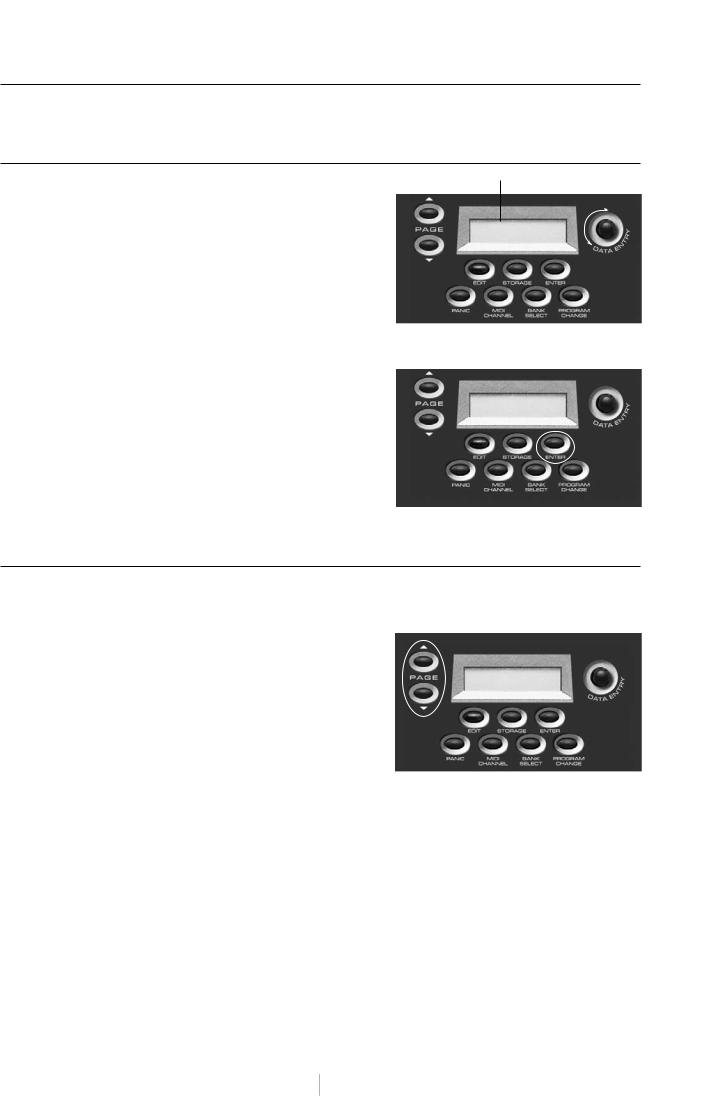
m a n u a l e d i i s t r u z i o n e |
VMK-149plus/VMK-188plus |
|
|
PROCEDURA: SELEZIONE PRESET
Il VMK-149/188 ha 27 preset programmabili dall’utente. Ci sono due modi per selezionare un preset.
SELEZIONE VELOCE (A)
1) RUOTARE IL POTENZIOMETRO DATA ENTRY
Ruotando il potenziometro DE farà scorrere l’elenco dei Preset. Il cursore lampeggerà.
Far scorrere fino al Preset che desiderate.
2) PREMERE ENTER
Aspettare finché il cursore smette di lampeggiare. Il Preset è stato selezionato.
Nota: É possibile visionare i Preset senza fare una scelta. Se non si preme il pulsante Enter,
il VMK ritorna all’ultimo Preset selezionato.
Il cursore lampeggerà
PRESET NUM: 1
NAME
PRESET NUM: 15
NAME
SELEZIONE VELOCE (B)
3) PREMERE PAGE Up/Dn.
Potete anche scegliere i Preset sequenzialmente, utilizzando i pulsanti Page up o Page down.
NOTA:
1.Dovete lasciare che il VMK scansioni i controlli prima che la scelta sia completa;
2.Potere spostarvi attraverso
i Preset soltanto uno alla volta.
PRESET NUM: 1 NAME
PROCEDURA: ATTRIBUZIONE DEL NOME
Il vostro VMK ha 27 preset programmabili dall’utente. Ciascun Preset può avere un nome di 10 caratteri al massimo. Ciascun nome può avere una combinazione di lettere o numeri a vostra scelta. Nel successivo esempio partiremo da un preset che è già stato programmato. Avete l’opzione di attribuire un nome al vostro preset durante il processo di editing. Quando avete completato i vostri edit ed avete raggiunto il passaggio relativo al premere il pulsante storage (vedi punto 6. nella Programmazione dei pulsanti, punto 7. in Cursori/Potenziometri/Pedali, punto 8. in Tastiera), seguite la seguente procedura:
27
p r e s e t s
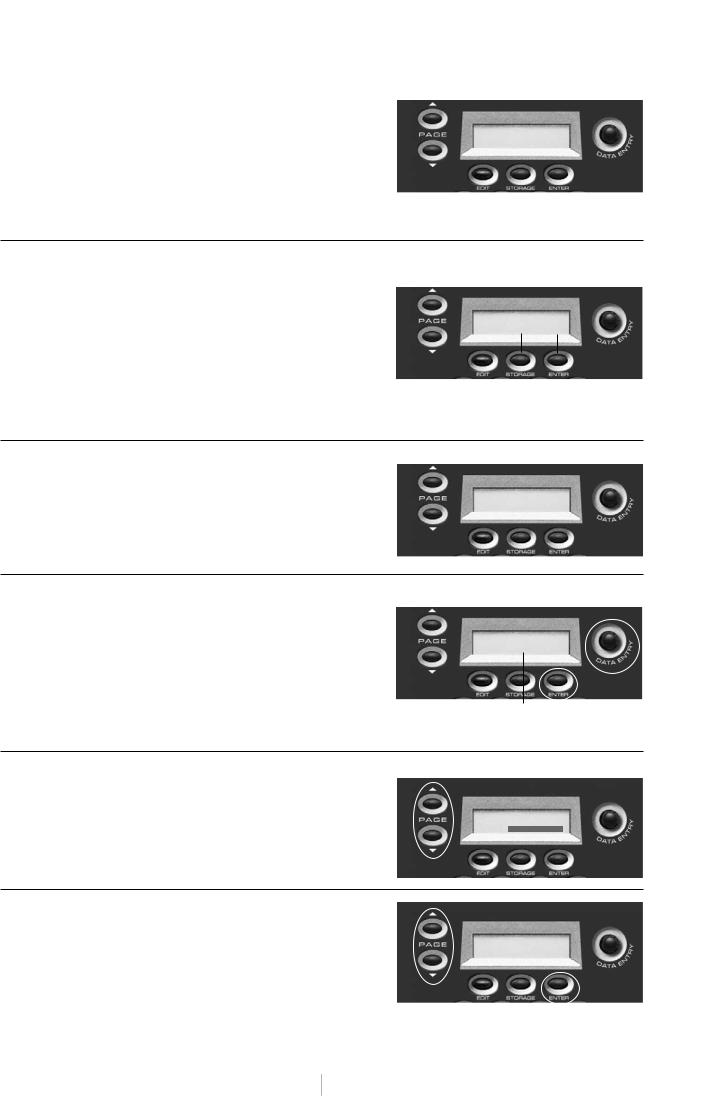
m a n u a l e d i i s t r u z i o n e |
VMK-149plus/VMK-188plus |
|
|
1) PREMERE STORAGE |
|
Salverete il vostro programma per un preset |
|
dell’utente (personalizzato). |
CAMBIO |
I pulsanti Storage e Enter adesso funzionano |
|
come pulsanti No o Yes. |
SCHERMO |
|
|
NOTA: |
|
Se selezionate No tornerete |
|
indietro alla Pagina “Press |
|
or Move any Control”. |
|
STORE PARAMETERS NO YES
2) PREMERE ENTRY (Yes)
In questo esempio sceglieremo Yes.
NOTA:
Se volete spostarvi ad una locazione diversa di Preset, usate
il potenziometro DE. QUESTO COPIERA’ TUTTI I DATI DEL PROGRAMMA
IN UNA NUOVA LOCAZIONE PRESET.
STORE PARAMETERS NO YES
3) PREMERE PG UP/PG DN
Premendo il pulsante Page Up o Page Down muoverete il
cursore sul campo Name del display LCD.
4) ATTRIBUZIONE DEL NOME
Il Cursore lampeggerà |
|
|
|
|
|
|
|
|
|
|
|
|
|
|
CAMBIO |
PRESET |
|
|
NUM: |
1 |
|||||||||
|
||||||||||||||
NAME |
|
|
|
|
|
|
|
|
|
|
|
|||
|
|
|
|
|
|
|||||||||
SCHERMO
Dare un nome al Preset usando sia i pulsanti Page che il potenziometro DE.
Ricordare che il nome può essere composto al massimo da 10 caratteri. Page Up: Muove il cursore verso destra Page DN: muove il cursore a sinistra Data Entry Dial: seleziona la lettera o il numero
PRESET NUM: |
1 |
||||||||||
NAME |
|
|
|
|
|
|
|
|
|
|
|
|
|
|
|
|
|
||||||
Il CURSORE si sposta sulla seconda riga del display
5) PREMERE STORAGE |
Select: Letter / Number |
|
Salverete così il vostro programma |
|
|
e il suo nome. |
PRESET NUM: |
1 |
|
NAME
6) PREMERE ENTER (YES)
Ritornerete alla pagina Preset con |
CAMBIO |
|
il Preset da voi identificato. |
||
SCHERMO |
ARE YOU SURE
NO YES
28
p r e s e t s
